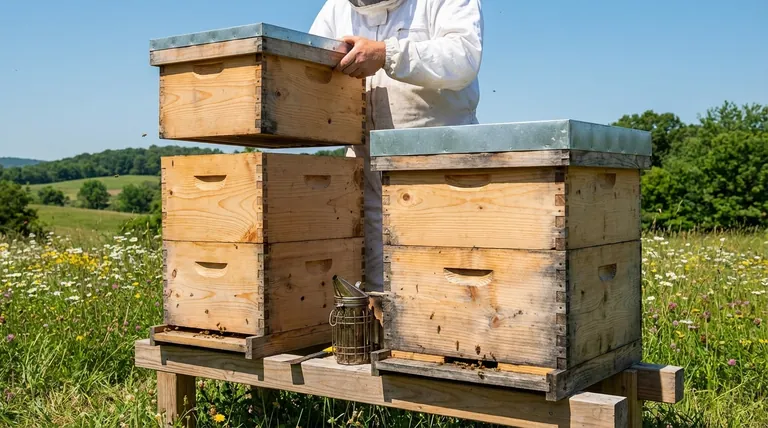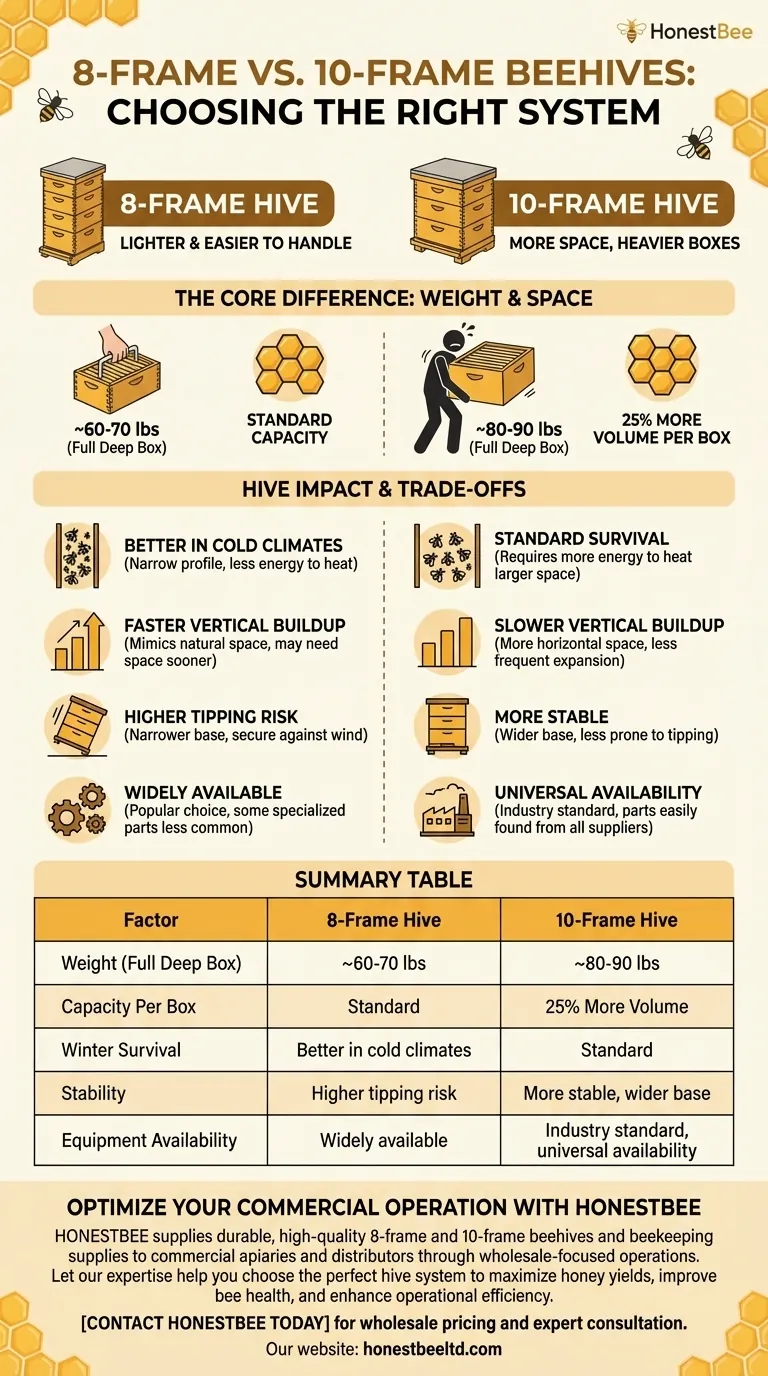Choosing between an 8-frame and 10-frame hive is a foundational decision for any beekeeper. The choice primarily hinges on a trade-off between the weight of the hive boxes and their total capacity for bees and honey. Key factors to consider are your physical ability to lift heavy objects, your honey production goals, your local climate, and the availability of compatible equipment.
The decision boils down to a simple principle: 8-frame hives are lighter and easier to handle, making them ideal for beekeepers concerned with physical strain. In contrast, 10-frame hives offer more space, potentially leading to higher honey yields and less frequent expansion, but at the cost of significantly heavier boxes.

The Core Difference: Weight vs. Space
The Weight Factor
The most significant difference, and often the deciding factor, is weight. A full 10-frame deep box can weigh 80-90 pounds, while a full 8-frame deep box is much more manageable at around 60-70 pounds.
This weight difference becomes critical when you are lifting multiple boxes during hive inspections or honey harvesting. For many, this factor alone makes the 8-frame system the more sustainable choice.
Hive Capacity
A 10-frame hive holds 25% more volume per box than an 8-frame hive. This means more room for the queen to lay eggs and for workers to store honey and pollen.
While this allows a 10-frame hive to hold more resources in a single box, a strong colony will simply require more 8-frame boxes stacked vertically to achieve the same total population and storage.
How Hive Size Impacts Your Bees
Winter Survival
The narrower profile of an 8-frame hive is often considered better for a colony's winter survival, especially in colder climates.
The bees form a cluster to stay warm, and the smaller "chimney" of an 8-frame box requires less energy to heat. This can lead to lower food consumption and a stronger colony emerging in the spring.
Colony Buildup
The dimensions of an 8-frame box more closely mimic the vertical space bees prefer in natural settings like a hollow tree.
This can encourage the colony to build up vertically more quickly in the spring. The downside is that they can also run out of space faster, potentially increasing swarm pressure if not managed closely.
Understanding the Practical Trade-offs
Equipment Availability and Cost
The 10-frame Langstroth hive is the long-standing industry standard. Consequently, compatible equipment is universally available from every supplier, sometimes at a slightly lower cost due to mass production.
While 8-frame equipment is very popular and widely available, you may find fewer options for specialized components. The initial cost for 8-frame boxes is slightly less than their 10-frame counterparts.
Frame Compatibility
It is critical to understand that the frames themselves are interchangeable. A deep, medium, or shallow frame has the same length regardless of whether it goes into an 8-frame or 10-frame box. The boxes are simply built with different widths to accommodate the number of frames.
Hive Stability
Because they are narrower and taller for the same internal volume, 8-frame hives have a higher tipping risk. This is a serious consideration if you live in an area with high winds. Securing your hives with straps or placing them in a sheltered location becomes more important.
Making the Right Choice for Your Goals
Your choice of hive equipment should align with your physical abilities and beekeeping objectives. There is no single "best" answer, only the best fit for you.
- If your primary focus is minimizing physical strain: Choose the 8-frame system. The significantly lighter boxes are the single biggest advantage for long-term beekeeping comfort.
- If your primary focus is maximizing honey per hive with fewer boxes: The 10-frame system is the traditional standard and allows for larger volumes in a more compact, stable configuration.
- If you live in a very cold climate: The 8-frame hive offers a thermal advantage that can improve winter survival rates for your colony.
- If you want the widest possible equipment availability and compatibility: The 10-frame hive remains the industry standard, ensuring parts are easy to find from any supplier.
Ultimately, the best hive is the one you can manage safely and effectively, so choose the system that best fits your body and your beekeeping ambitions.
Summary Table:
| Factor | 8-Frame Hive | 10-Frame Hive |
|---|---|---|
| Weight (Full Deep Box) | ~60-70 lbs | ~80-90 lbs |
| Capacity Per Box | Standard | 25% More Volume |
| Winter Survival | Better in cold climates | Standard |
| Stability | Higher tipping risk | More stable, wider base |
| Equipment Availability | Widely available | Industry standard, universal availability |
Optimize your commercial operation with the right hive equipment. HONESTBEE supplies durable, high-quality 8-frame and 10-frame beehives and beekeeping supplies to commercial apiaries and distributors through wholesale-focused operations. Let our expertise help you choose the perfect hive system to maximize honey yields, improve bee health, and enhance operational efficiency. Contact HONESTBEE today for wholesale pricing and expert consultation.
Visual Guide

Related Products
- Langstroth Bee Hives Bee Keeping Box for Beginners Beekeeping
- Australian Langstroth Beehive Boxes for Beekeeping Wholesales
- Langstroth Honey Bee Box Hive Boxes for Different Depths
- Professional Insulated Plastic Bee Hives
- HONESTBEE Professional Long Handled Hive Tool with Precision Cutting Blade
People Also Ask
- What is the best type of bee hive for beginners? Start with the Proven Langstroth Standard
- What are the different types of beehive boxes available? Choose the Right Hive for Your Apiary
- Why are Langstroth hives recommended for beginners? Unmatched Support & Standardization
- What basic equipment is needed to start beekeeping? Your Essential Guide to a Confident Start
- What are the key features of the Langstroth beehive? A Guide to the Standard for Modern Beekeeping



















